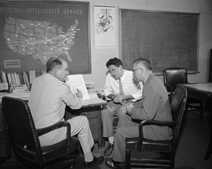CDC Ramps up Support for Final Push in Global Polio Eradication Effort
On Wednesday, December 14, CDC Director Thomas R. Frieden, M.D., M.P.H., charged the entire CDC community to become active participants in an intensified strategy to eradicate polio, worldwide. The briefing followed Dr. Frieden’s December 2nd announcement activating CDC’s Emergency Operations Center for the agency’s partnership engagement through the Global Polio Eradication Initiative (GPEI). GPEI is committed to eradicating polio by the end of 2012. For more about CDC’s Emergency Operations Center, see https://www.cdc.gov/phpr/eoc.htm.
Isn’t Polio Gone?

Members of CDC's Polio Surveillance Unit in the 1950s: Alexander Langmuir is sitting on the left, Jack Karush (EIS '54) is in the center, and CDC statistician Robert Serfling is on the right.
Polio, or poliomyelitis, is an infectious viral disease that can strike at any age and affects a person's nervous system. In the late 1940s to the early 1950s, in the U. S. alone, polio crippled around 35,000 people each year — making it one of the most feared diseases of the 20th century. Yet, thanks to a massive vaccination effort, by 1979 the country became polio free. For more about polio and how it was eradicated in the U.S., see “A Polio-Free U.S. Thanks to Vaccine Efforts,” https://www.cdc.gov/Features/PolioFacts/. The eradication of polio from the western hemisphere of the world is one of the most significant public health achievements of all time. But victory over polio cannot be claimed until the entire world is made safe from the disease and this commitment has been made by the global public health community.
The Early Years of CDC’s Fight against Polio
The fight against polio has been part of CDC’s mission since the 1950s, and the global push to eradicate polio is just the latest chapter in CDC’s polio efforts. Shortly after CDC was created, it established a national polio surveillance unit (PSU) headed by CDC’s Epidemic Intelligence Service (EIS) founder Alex Langmuir. CDC worked collaboratively with the two giants in polio eradication, Dr. Jonas Salk, of the University of Pittsburgh who developed the inactivated polio vaccine (IPV) in the early 1950s, and Dr. Albert Sabin, who developed the oral polio vaccine (OPV) in the early 1960s. CDC’s PSU staff and EIS officers worked to administer both the Salk and Sabin polio vaccines and also gather and analyze surveillance data.
CDC’s Chief EIS Officer at the time, Ira L. Myers, M.D., M.P.H., remembers the collaboration of CDC’s PSU and EIS with Salk and Sabin as something monumental, “As I think back on it, to sit in a conference room where Jonas Salk and Albert Sabin were sitting across from each other trying to decide whose vaccine was going to be first, is something that stays with your memory forever.” For more about CDC’s role in the early days of polio vaccine administration and surveillance, see “‘Bright, Aggressive, and Abrasive:’ A History of the Chief Epidemic Intelligence Service Officer of the U.S. Centers for Disease Control and Prevention,1951 – 2006”.
- Page last reviewed: March 19, 2014
- Page last updated: March 19, 2014
- Content source:


 ShareCompartir
ShareCompartir